No matter what market your company is playing in, no matter how big your company is, scaling is something that all SaaS founders and C-suite executives need to think about. Elay Cohen (Co-founder, Saleshood) sits down with Hilarie Koplow-McAdams (President, New Relic) and Lindsey Armstrong (COO, InsideSales.com) to pick their brains about the lessons they’ve learned about scaling and what it means to them.
Scale used to be about growth at any cost, like hiring sales rep after sales rep, hoping that it will bridge the gap between product readiness and success with customers. Hilarie and Lindsey firmly believe that it’s about repeatability and understanding how and why you’re going to dominate a particular market.
This also speaks to scaling globally. You can’t just try to enter multiple European countries at once, something that a lot of companies have done, without performing your due diligence. What are the labor laws? What are the growth economies? What are the public policies around data privacy?
As for culture? Free snacks and a ping pong table are not culture; those are bribes.
And if you haven’t heard: SaaStr Annual will be back in 2018, bigger and better than ever! Join 10,000 fellow founders, investors and execs for 3 days of unparalleled networking and epic learnings from SaaS legends like Jyoti Bansal, Dustin Moskovitz, Jeff Lawson, and Michael Pryor. If you don’t have tickets, lock in Early Bird pricing today and bring your team from just $799! (All ticket prices go up October 1st.) Get tickets here.
TRANSCRIPT
Announcer: He’s now CEO and co founder of Saleshood and was previously Senior Vice President of Sales Productivity at Salesforce, where he taught the best of the best how to sell better. Please welcome Elay Cohen to the stage.
Elay Cohen: Well, hello, everyone. How are you doing today? Let’s get everyone in here.
My name is Elay Cohen. I’m the CEO of Saleshood and super excited to be hosting a fabulous panel, also the former Senior Vice President of Productivity for Salesforce, so I’ve experienced a little bit about scale.
I’m super excited to have two amazing leaders here, amazing professionals, folks that we were talking a little bit about in the pack. Each one has seen 35 years. Lindsey Armstrong has a 35 years of carrying quota, and Hilarie Koplow McAdams is over 30 years.
Just a brief couple of words, Hilarie is long time executive leader from Oracle, Intuit, and Salesforce. We worked together at Salesforce. Super excited that you’re here. Most recently, President at New Relic.
Lindsey is also longtime Oracle, Symantec, Veritas. We worked together at Salesforce as well. Now she’s the COO at InsideSales. Warm welcome to our amazing leaders who are here. Give them a round of applause.
[applause]
Hilarie Koplow McAdams: Thank you, Elay.
Elay: We’re here to talk about scale. Before we talk about scale, let’s hear about you. Tell us just to kind of set context. New Relic, what do they do and how’s it going over there? Congrats on the earnings.
Hilarie: Thank you. We announced our earnings this week. It’s our fourth quarter, so we announced third quarter earnings. How many people on the audience know what New Relic does? Excellent, looks like we have a lot of understanding out there.
I’ll just give you a little overview of the company. We’re about $250 million company now. We consider ourselves a growth company. We’re the fastest growing company in this enterprise segment. It’s really application performance monitoring in its incarnation.
We’ve really moved to a new strategy where we’re helping customers measure their digital experience. What we’re seeing in the mass market is everybody’s moving to a digital experience to engage their customers, whether it’s a SaaS application or a consumer experience.
It’s all digital. We’re embedded inside these experiences and helping them measure what that looks like. It’s been a fantastic, fast run. I’ve been there three and a half years. We went public two years ago, and it’s been great.
Elay: That’s amazing. Congratulations, New Relic President. It’s super, super rare. We’re going to dive into some of the stories.
Lindsey, tell us how are things going at InsideSales?
Lindsey Armstrong: Congrats to InsideSales, guys, we just did a $50 million raise. The reason that people are investing in InsideSales is they see that this sales acceleration space, and the ability to use the massive datasets that we have to predict how sales reps should behave on their daily basis as an enormous space that people get into.
That’s what we do. We’re sales acceleration space and we do predictive tools so that sales reps can become more productive.
Elay: That’s great. InsideSales and New Relic are both on the fast path, different stages. I thought it would be great, since we’re talking about scale, let’s level set what scale means to each of you?
Let’s explore that for a little bit. Why don’t we start with Lindsey? Lindsey, scale means so much to so many different people, what does it mean to you?
Lindsey: For everybody in the audience, the key thing is you better understand what scale means to either your leadership team or to the board if you’re CEOs in the audience.
Scale used to mean growth at all cost, or growth at any cost. It’s about market grab or market share. That’s no longer, I think, the way the companies and investors view scale.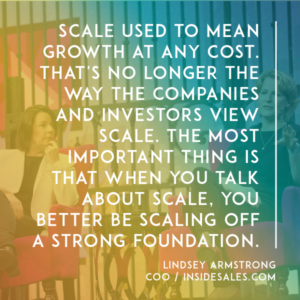
Scale is going to be different depending on what size you are of a company. The most important thing is that when you talk about scale, you better be scaling off a strong foundation. Again, the tendency when you talk about scale is, it’s chucking bodies at it. It’s throwing a whole bunch of salespeople at it.
In fact, the levers for scale are actually very few. All of you only have a couple, probably, four or five levers to pull. You have your ARR lever, which is an expression of what the market will bear, market opportunity.
You have your churn, that’s both net and growth attrition. Your growth attrition is an expression of how happy people are, of customer happiness. Your net attrition is about product.
That’s what tells you how people add more uses or expand it to more products. You have revenue which is obviously a trailing metric. You have a metric which is not often looked at in SaaS, and that’s payment terms, because payment terms lead into the thing that is very important to everyone that is cash burn.
Those are the only real levers that you guys have to pull in terms of being able to understand what scale is. The way that successful companies, that winning companies approach scale is to look at, again, from those metrics, but from a very small number of key things.
The first for me is repeatability. The key to all scale is repeatability. If you don’t have repeatability, you can grow the company but you will never get to knowing how to get cash burn positive. Firstly, it’s repeatability.
Secondly, it’s understanding from either the board or investors, whoever the leadership is. It’s understanding from them the balance that they want to draw between growth and cash burn because of course, you can grow a massive company, but burn just a ton of cash. Those days I think are behind us.
That leads us into the third thing. That is, as you scale, you must understand how you’re going to get to be cash burn positive. If you understand how to get to be cashflow positive, you don’t actually have to get there and you don’t have to be there, but you have to know, you must know how you would get to a cash flow positive scenario if you had to and if the needs were there.
When you look at this whole idea of scale, scale is very different depending on the different stage you are in the company, but I think the levers remain the same and the principles remain the same whether you’re a small company or a large company.
Elay: Lindsey, you’re an operational machine. I think folks that know Lindsey, just the cadence and the discipline around driving metrics is astounding. It’s amazing to see and that’s awesome.
Hilarie, what’s your point of view on scale as you’ve lived through so many amazing growth stories?
Hilarie: Yeah, I agree with everything that Lindsey said. I’ll give it a different angle as well, a consideration. To me, in my mind, scale is just about going as fast as you can, but the qualifier is when you choose to do that.
You have to be ready to scale. The balance is so hard. I see companies go too fast to scale, I see companies go too slow to scale. I think the key essence…The KPIs that Lindsey described help you understand where you are on your journey and what’s important to your investors.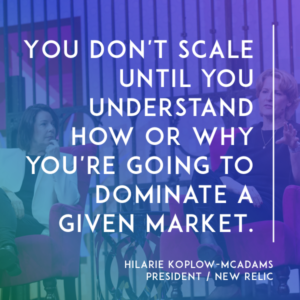
To me, you don’t scale until you understand how you’re going to dominate or why you’re dominating a given market. It really goes back to a focused playbook. Once you scale, what’s super important to get right is to synchronize your investments.
I think a lot of people scale up, the products start selling or the offerings start selling, they think they’re in front of a tsunami, but they’re not.
They’re not scaled for the product, particularly in a multi tenant SaaS environment to have the peaks that lots of customers arriving at once will drive the…You might have the sellers in place, you may not have the supporting resources for the customers.
I think a mistake that I’ve made in my career is not investing early enough in the customer success pieces to make sure that customers are going to be successful or at least you have a playbook for what success looks like so that you don’t hit the churn issue that Lindsey raised.
Once you hit the negative issues, then you go into firefighting mode and it’s hard to scale.
I’d love to talk a little bit more as we get further into the conversation about synchronizing the investments whether you’re scaling in a geography or you’re going for a global position. It’s really important to think about how you line the resources up so they execute in motion together.
Lindsey: I think one of the things that you see or that, as Elay so kindly introduced to us, I think he basically called us old.
[laughter]
Hilarie: I heard that.
Lindsey: One of the things that you will see as a theme is companies very often do this ballooning up. They get some cash, they hire hundreds of people and try and go into nine countries in Europe at the same time.
They realize that they haven’t got either the cash burn window that they need to do that or success doesn’t come in the way that they planned it. They then contract down again and then they try and balloon out again. This constant contracting down and going out and contracting down is really brutal in a company.
The way that you get round that is by having exactly what Hilarie said, which is a really clear understanding of how the money runs, how you can get that runway in each of those different scenarios?
A rule of thumb that I think it’s a really good one is if it’s customer facing folks, you scale just in time, but if it’s infrastructure folks, always scale not quite in time.
You should have an infrastructure that’s always pushing. There’s always a tension so that it’s always pushing up against those customer facing folks. I’m sure that’s what you’ve seen as well.
Hilarie: Yeah, I think those are great points. Globalization is a tricky one. How many people in the audience are thinking about globalizing, entering new markets? Is that a common theme?
I will tell you, as you hire people around the globe or you interview people or you talk to customers or multinationals, if you’re in the enterprise space, they’ll often ask you to enter a geography in support of them. You have to be pretty careful about it.
There are a couple things that I always look at when we enter a country. Number one, I start with public policy around data privacy. It was important for the last 10 years.
I think it’s going to be more important in the future, so understanding how that country thinks about where the data resides and what limitations that might put on you from a barrier of entry point of view.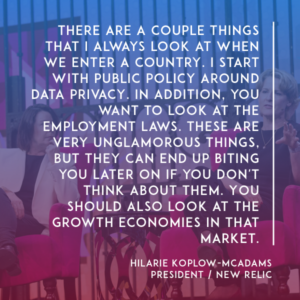
In addition, you want to look at the employment laws. These are very unglamorous things, but they can end up biting you later on if you don’t think about them.
Look at the growth economies in that market. It needs to be a high growth country. Usually, start with the English speaking countries. You want positive GDP growth in verticals that you’re doing well in, and then you want to target acre tenants or the middle of an economy.
Like in Germany, you might go after the mittelstand as being a really interesting entry point, and then laying your assets to focus on the target.
At Salesforce, we were really disciplined. We had a top eight country strategy. I think at the time that we had that strategy, we were probably a couple billion dollars. I think people would be surprised that we weren’t just trying to spread out all over the world.
The fundamental reason we weren’t was we couldn’t scale the supporting cast and we couldn’t support the sellers and the product in those economies effectively for our customers. We had to think about concentrated focus to enter Japan, to enter Australia, to enter the UK, to go into the different countries of continental Europe with critical mass.
I think that’s just so important to have that discipline but what it comes down to is a focused plan.
Elay: I remember back then when there was a top eight country strategy and there were some tough decisions we had to make.
Hilarie: Very tough decisions.
Elay: There are a lot of leaders that wanted their country to be chosen. How do you work through those decisions when you’re doing some international go to market rollouts?
Lindsey: I broke a lot of hearts in Europe when Italy didn’t make the top eight.
Hilarie: Italy, right…
Lindsey: Just on the sequencing though, I think this is really important to think about the sequencing because depending on what size you are and in fact what your objective is, that really does inform that strategy.
Again, the tendency is to do exactly what Hilarie described and say, “Great. We’re going to go into Europe. That means opening six countries.”
If you’re a small company and your goal actually is an exit, that’s absolutely not what you want to be doing. Scale to you means demonstrating that you can do something, not necessarily that you do do something.
For example, building value and creating value in your company will probably be greater if you demonstrate that you can organically grow in a country like the UK and maybe Germany or Australia that you can grow by acquisition by potentially entering another territory through a small acquisition, but not by fulfilling the ambitions that you may have and actually going out and entering six different countries.
If you’re a smaller company, that’s what scale will mean to you. Scale means something bigger. When you’re doing what Hilarie’s doing, which is heading up a public company, this growth strategy is a very different strategy.
What she’s trying to do is to follow this focused strategy of coming into countries either with products where she can drive immediate success, get a ton of traction, and be able to demonstrate leadership within those markets. I think there are two different, again, competing scale agendas, very much dependent on the size that you’re at.
Elay: Let’s go somewhere for a second. When we’re at Salesforce, reps, reps, reps, hire, hire, hire, grow, grow, grow and there’s a general belief that you want to grow fast, you want to scale fast, you just hire a bunch of reps.
What happens when you hire too many reps too fast? What happens to the business and what advice would you give people around that?
Hilarie: It’s a great question and we should both the weigh in on this. There’s a gentle balance where you want to try to assess what your demand curve is that you’re sitting up against in the market that your marketing team is generating or the market is creating for you and try to size it appropriately.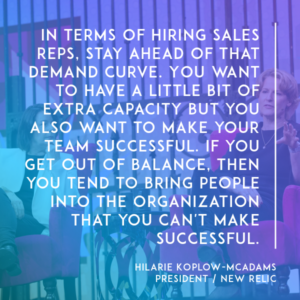
My best advice is to be ahead of that demand curve. You want to have a little bit of extra capacity, but you want to make your team successful. If you get out of balance, which is what you’re describing, then you tend to bring salespeople into the organization that you can’t make successful, technical people into the organization that you can’t make successful.
That can create a real spiral down of morale. You have to really think about how you set people up for success before they even get that offer letter, so it goes without saying. I’m sure everyone’s talked about it.
Get the best people you can, get people with networks or get people who are really aggressive and want to learn and you can put them into a program, but then enable them.
That comes back to aligning around a couple core strategies. Have an idea of how you’re going to win or dominate as I like [laughs] to talk about a given market or a given approach.
Operationalize that domination strategy into a playbook that you can hand off to your new sellers. It’s really anyone in a customer facing role. It could be customer success, it could be a technical resource, it could be a salesperson.
Enable them with that and then help them get traction so they get success in that market because what you’re doing and it reminds me of what Michael Dell always used to talk about. He’d tell us, general managers, “Go build this BU and then when it gets to a certain size, I’m going to split it in half and I’m going to ask you to double it again.”
That’s essentially what you’re doing when you’re driving these growth strategies. You’re trying to take five to 10 and then you’re going to split the responsibility for the leader and you’re going to say, “OK, take that five that’s left, take it to 10 again.”
If they falter in that path, if you don’t think about success of the employee, success of the customer, and synchronize the investment so you’re getting the marketing coverage, you have the pipeline support, you have a product that’s robust enough to go and support volume, which generally if you’re successful, the volumes can grow pretty dramatically then it all works.
Getting out of synchrony, it’s a big deal.
Elay: Giving them a playbook. I love it.
Hilarie: A playbook, absolutely.
Elay: Lindsey, what do you think?
Lindsey: I think it depends what markets you’re selling into. The risk and the scale that you want to take if you’re an SMB vendor versus an enterprise vendor is entirely different. This is all about the risk profile that you can tolerate as a company.
The first point that I make particularly about enterprise is companies always overestimate how difficult it is to hire sales reps. Almost always, companies that fail or falter in the way that Elay described are companies who’ve hired a ton of reps far ahead of when product which is ready.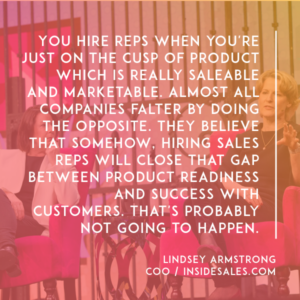
You hire reps when you’re just on the cusp of product which is really saleable and really marketable. Again, almost all companies falter by doing the opposite. They believe that if you sell it, they will come and that somehow, hiring sales reps who go out and sell something will close that gap between product readiness and success with customers.
That’s probably not going to happen. If you look at a company that is balanced, my goal when building businesses is always about risk. You never want one thing to be able to take you down as a company, so no product, no territory, no individuals get you out of balance as a company.
The way that that feeds into the question about when do you hire and what does this ballooning look like? Again, it comes back to where you’re going to take risk.
If you’re a company that has a strategy that says we can sell this small business and all the way up to the enterprise, all the way through, very much like a Salesforce or like a New Relic, if you’re going to do that, you can afford to spread that risk.
It means that you can afford to stay in that game of hiring enterprise reps much longer if you have a revenue at the bottom end of your business which balances that out.
If your SMB business is cranking, you can pile people and heads into enterprise and really wait and build a strong business. If you don’t have that balancing piece, you’re in a very different position.
Elay: No, it’s great. We have a lot to cover. There’s so much we could talk about in such a short period of time if we talk about scale. We want to give everyone a slice or the variety of different areas that you should be focused on, so I think we should shift a little bit to culture.
I think we’ve talked a lot about go to market and hiring reps and capacity, and there’s equations and formulas for all that. We’ve all been in amazing companies and we’ve seen cultures grow and we’ve seen sometimes cultures not grow the way we want them.
How do you sustain that amazing culture when you are a smaller tight knit organization? How do you scale culture? Let’s talk about that. Who wants to go first?
Lindsey: You go first. [laughs]
Hilarie: OK, I’m happy to go first on that. I think every company is a little country or community with its own cultural values that often come from the founder or their early folks in the company. Getting clear about what you stand for in your community is so important.
I hope today in the market that we’re in, with SaaS applications or what Amazon has done to the market, that most cultures embrace a customer centricity.
I think the days of being the big, bad, overbearing vendor to the customer is gone and that for most companies today, their core principle is being very customer centric and being in service to their customers as well as the market.
That doesn’t mean you’re not innovative. In fact, you have to fight that tension to continue to innovate, but really, saying to your company that all of us are here on behalf of our customers I think is just core.
Doing a values inventory and then every story that you tell in the company, every customer engagement, every piece of recognition of the engineering team or the product team or the heroes of the company or the failures that you experience on the way to success have to reinforce the cultural values.
I’ve seen companies do amazing jobs of giving recognition around culture where I can spontaneously give Lindsey an award because she represents a cultural value. I know at New Relic, on an annual basis, we recognize a group of people that stand for our cultural values.
One of our unusual values is that we feel that everyone in the company should be authentic. Anyone who knows Lew Cirne, our founder and CEO, he’s a really authentic guy.
All the “Relics” at New Relic have this great pride about being able to bring their whole self to the company and being authentic. That’s really part of our vibe and we celebrate that.
What I will tell you is that, and we should spend more time on this, I’ve never been in a company where the Fortune magazine article makes it look really easy and smooth.
The reality is, whether you go back to my early days at Oracle when we were both there when the company was…I don’t know, 100 million, 200 million?
Lindsey: 100 million.
Hilarie: [laughs] It was a startup and I left at 11 billion. I think you left at a couple billion. It was a bunch of S curves, right?
Salesforce had a similar trajectory and New Relic, we have our S curves as we pivot from an SMB company to an enterprise company as we move from a single product company to a platform company. All of these are challenging things to execute.
There’s only one thing that you have at the end of the day when you’re going through those changes. That’s the offering and your core values. I just think it’s essential.
Elay: It’s amazing. I visited the New Relic office and seen in the lobby, the values are there. One thing that you just said which is fascinating to me is the vibe. I think New Relic does a great job bringing the values to life and creating a real vibe that unifies everyone. Nice.
Lindsey, what are your thoughts on scale and culture?
Lindsey: You can’t scale a company without having a strong culture and a strong purpose. Let me tell you what a culture is not. A culture is not free snacks or a table tennis table. Those are bribes.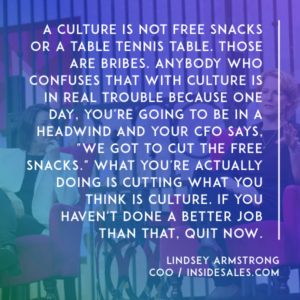
Anybody who confuses that with culture is in real trouble because one day, you’re going to stand up and you’re going to be in a headwind and your CFO says, “We got to cut the free snacks.”
What you’re actually doing is cutting what you think is culture. If you haven’t done a better job than that, quit now because it’s so important that people don’t confuse the things that surround a company that you try and throw out there to make them attend the office and not go home before 10 o’clock at night. Do not confuse those with actual culture.
The second point that I think that I make about culture is as you scale a company, you hire tons of new people. Maintaining that culture is a real trick because there are a bunch of people in your company who know where you’ve come from and you’re going to hire a bunch of people into the company who know where you’re going. You have to bridge those.
You cannot have a company whereby all the new people discards the old people because they know where we’re going. It is essential that you hire people who can embrace all of those people, not just for cultural reasons.
If you hire a whole bunch of people into the company who have got a very different culture, trash your old people, then those guys go, you’re going to reset the clock another two years. You’re going to go back and these people will turnover.
The culture of a company is very much about how you can take those people who know the real hardships, the guys who mortgaged their house to get you through the first million dollars or to hire another five engineers.
Those people are in the company and they must be valued, but they can’t be valued out of balance with the people who are going to take you to where you know you’re going. That’s really tough.
The toughest person on that is the CEO. CEOs, when talking about scale, the elephant in the room is how do you scale your CEO, right? Obviously, if there are any CEOs in the audience, we don’t mean you because you guys are very self aware and massively evolved.
[laughter]
Lindsey: Other CEOs, you’ve got to scale your CEO and that he/she in some ways is the custodian of your culture. Scaling that CEO so that where you’re able to retain the right people but you don’t build a culture of special people who are untouchable that can’t be fired no matter what, again, it’s a real task.
The board has to come down and do it and the guys that are hired, the layer below the CEO, those are the people who are really responsible for driving that balance. We’ve seen some fairly interesting CEOs…
Elay: How do you scale CEOs?
Hilarie: I think scaling not just the CEO but the CXOs. I think Lindsey made a great point. The people who built the company to 50 million or 100 million often find the next chapter hard and challenging, especially if they haven’t experienced it in another company. They don’t have the pattern matching in place.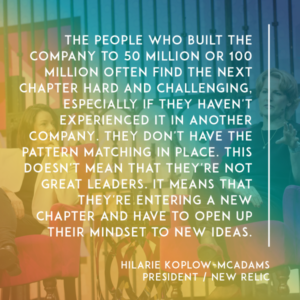
This doesn’t mean that they’re not great leaders. It means that they’re entering a new chapter and have to open up their mindset to new ideas because there are differences when you’re trying to build a market and figure out what’s going to stick and then when you think you’ve got scale and you want to go fast.
Ultimately, you hit another headwind. You’ve got to walk through that. The best trick that I’ve found to open up people’s mindset is to bring in great consultants. Sometimes, it’s hard to hire people in. You get a little bit of organ rejection. I talk a lot about fear when I am in leadership settings, letting people let go of their fears so they can be open to new ideas.
The best experience I’ve had is bringing in a consultant that’s a specialist in…call it customer success or engineering at scale or whatever it might be, and get them to bring their expertise to the table to loosen everyone up a little bit in their thought processes. As they bring new ideas, you can institutionalize them with full time hires.
I don’t know if you’ve had that same experience, but I find bringing in consultants has been fabulous.
Lindsey: You need a catalyst. You need some kind of catalyst to keep raising the game. When Veritas bought OpenVision…I went back to the UK. The company was $8 million in run rate revenue. When I left, it was $2 billion.
We’d actually scaled with largely a lot of the same people, but the only way that we could scale in that way was by continually, at every gate, at the $50 million gate, at the $100 million gate, at the $250, at every single gate that you get to, you need to bring something in that will catalyze that community.
Some people go and some people join, but you’ve got to lift it. You can either do it with consultants. Often, companies do that by acquisition. They acquire a company that has a very compatible culture and that rising tide takes all people with it.
Hilarie: I think that makes a big difference. The other thing I’ll tell you is I always set the expectations with my team that every year, 30 percent of the people at my staff table will be new. It doesn’t mean it’s musical chairs and someone’s leaving. It may be some incremental hires.
It basically means 30 percent of the people at the table have to have a new voice every year because when you’re in these high growth situations, you absolutely need new insights, new voices, fresh eyes to help you understand what’s not working well or what is working well and you need to go faster on.
Elay: We’ve talked about go to market, we’ve talked about culture, leadership. One of the areas that I think a lot of companies struggle with is decision making.
Hilarie: Yeah.
Elay: How do you distribute decision making to your leaders? You both are great leaders of your companies. How do you scale that decision making?
Lindsey: I think this comes back to the philosophy of the CEO actually because if you think about a CEO, actually they’re only supposed to do two things: create the vision of the company and make decisions.
As CEOs grow and as companies grow, that second piece, the making decisions, becomes very difficult. Distributing that out, I think it depends on…You need to have a CEO that will believe in the management team underneath them and the management team needs to have proved themselves and be trustworthy and help the company make good decisions.
You also need to have a culture that enables failure because my view of decision making is if I get 51 percent of them right, boy, am I ahead. I’m way ahead of the game. If I’m trying to wait until I’ve got all the data, I’m way behind the game.
I don’t know about anybody else here, but we’re swimming in data. I have more data than you can shake a stick at, but it’s not really helping me make decisions. It’s just giving me more data.
Fundamentally, as leaders, what we have to do is take the data, translate it into the experience that we’ve got, make those decisions, and constantly keep moving and assume that you’re going to make most of your decisions correctly.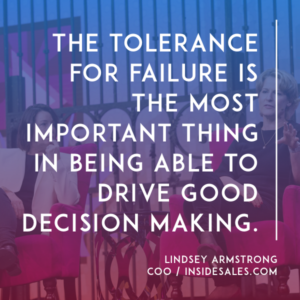
If you don’t, we’re going to learn from that. We’re not going to repeat those mistakes, but we are going to make a lot of mistakes. The tolerance for failure is the most important thing in being able to drive good decision making.
Hilarie: My experience is not dissimilar. When you feel like you’re whitewater rafting, lots of decisions come to the sea level, which could be overwhelming.
I see that as a symptom of the fact that we haven’t clarified decision rights. We actually spend a lot of time now internally talking about who has the decision right, and being really explicit about letting decisions sit at a lower level.
What I always say philosophically is if it feels risky, and you want to present the risk alternative A, alternative B, I’m happy to hear it, but bring me a recommendation.
Try to empower people to not only have the decision rights but have a point of view on what they’re recommending with some knowledge of the risks.
I go back to, I worked for this fabulous guy at Intuit, Steve Bennett was the CEO and he always said, “The strength of a CEO is in the questions that they ask, not the answers that they give.” I think it’s beautifully said.
If you’re a CEO and you’re answering all the questions, and trust me, it’s super hard. You can answer questions faster [laughs] if you do it on your own, but you run into a scale problem, which is why you have to have the discipline to not answer.
If you can resist the urge to answer and throw back the question of what would you recommend, given all the things you just described, it really empowers your people and it tells them that they have the decision rights.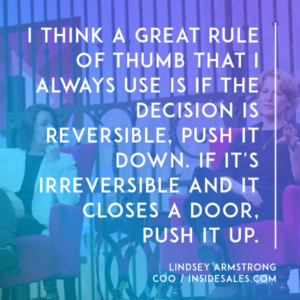
Lindsey: I think a great rule of thumb that I always use is if the decision is reversible, push it down. If it’s irreversible and it closes a door, push it up. It’s just a really simple way of looking at it.
Hilarie: Nice. I’ll take that.
Elay: I’m super fortunate to have you both in my life. You’ve both been amazing mentors to me personally and to all the teams that I’ve been working with.
Hilarie: Likewise.
Elay: Thank you. We’ve got thousands of people here. SaaStr is a machine of sharing the content globally. Millions of people are going to watch this, and we’ve got so many founders that are at beginning of their journey.
What would be that one piece of advice, if you could wrap up culture, go to market, decision making, growth, that you want to leave everyone with now on scale, a big one?
Lindsey: I’m going to go with a really easy one, which is enjoy the ride. Scaling companies is like the best fun that you’re ever going to have, so I’m going to go with just enjoy the ride.
You guys can make the decisions. We can give you as much advice as you want, but this is a tremendous opportunity. We live in a great time for scaling really big companies.
Hilarie: I’ll do the flip side. Have no fear. Just do it. [laughs]
Elay: Enjoy the ride. Have no fear. A big round of applause for Hilarie and Lindsey for sharing their words of wisdom.
Elay: Thank you.
Lindsey: You’re welcome.

